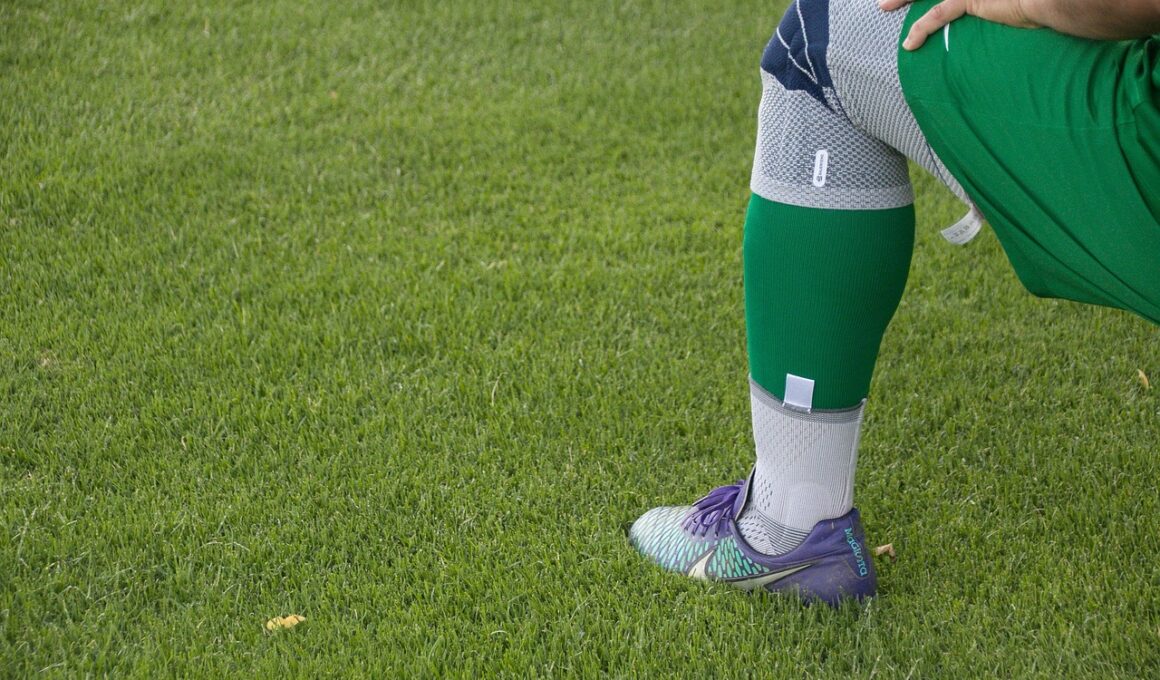Gender Differences in Injury Types and Management in Fitness Sports
In fitness sports, understanding gender differences in injury types is crucial. Men and women engage in various competitive activities, which may lead to different injury patterns. Studies show that women tend to experience more knee injuries, whereas men face issues in ankles and shoulders. Additionally, the type of sport played often influences injury prevalence. For instance, female athletes in gymnastics face unique injury risks due to the physical demands of their sport. Men, on the other hand, may encounter injuries resulting from higher impact activities such as rugby or football. Tailored injury prevention programs become essential in addressing these differences effectively. Furthermore, psychological factors, such as pain tolerance and motivation to perform, vary significantly across genders. Social and cultural influences may also play roles in how injuries are viewed and managed. Organizations can utilize this data to create targeted interventions for injury prevention. To minimize risks, both genders should engage in proper training techniques and recovery practices. Understanding these distinctions helps coaches and athletes design better protocols for performance success while prioritizing health and well-being.
Injury management practices must also adapt to gender-specific responses, emphasizing rehabilitation approaches tailored for both men and women. Research indicates that women may experience longer recovery times compared to men after similar injuries. Factors such as hormonal fluctuations can influence pain perception and healing rates in female athletes. Additionally, men might adhere differently to rehabilitation programs, which can impact injury outcomes. It is vital for trainers and healthcare providers to recognize these variations when developing recovery plans. Implementing evidence-based strategies that consider gender differences leads to more effective rehabilitation processes. For instance, female athletes could benefit from programs emphasizing functional movement patterns and strength training specifically targeting common injury sites. Meanwhile, programs for male athletes might focus on explosiveness and agility to prevent injuries in contact sports. Educating athletes on the importance of personalized management plans fosters a culture of injury awareness. Open communication between coaches, athletes, and healthcare professionals is essential in promoting recovery and preventing reinjuries. Both genders can enhance their performance through tailored management strategies that address the unique challenges they face while competing and training.
Common Injuries by Gender
Awareness of common injuries across genders is necessary for effective prevention and management. Female athletes frequently suffer from injuries such as anterior cruciate ligament (ACL) tears, stress fractures, and tendinitis in various sports. The risk of ACL injuries is notably higher in women due to anatomical differences and hormonal effects. Men, contrastingly, often face shoulder injuries, particularly rotator cuff tears, and lower back injuries, as well as common sprains. Furthermore, specific sports can predispose athletes to unique injuries. For example, runners are susceptible to patellar tendinitis, whilst weightlifters may experience lower back strain. Participating in high-contact sports escalates the risk of fractures, concussions, and dislocations for both genders. Understanding the prevalence of these injuries aids in developing targeted prevention programs. Comprehensive training regimens that prioritize flexibility, strength, and proper technique can mitigate injury risks. Ultimately, fostering awareness among athletes can promote proactive measures, encouraging both men and women to prioritize functional conditioning and skill development. Strengthening the body as a whole helps athletes maintain longevity in their athletic careers while lowering their risk of injuries significantly.
The psychological aspects of injury management also present distinct challenges for different genders. Female athletes often exhibit higher levels of anxiety and emotional distress following injuries, which can hinder recovery. They may fear reinjury, leading to hesitance in returning to their sport. Male athletes, conversely, may struggle with societal pressure to portray toughness, often downplaying pain or injuries. This behavior can delay recovery and exacerbate underlying issues. Recognizing these psychological factors is critical for medical personnel and coaches. Strategies, such as providing mental health support, can help facilitate recovery by addressing fear and anxiety related to injuries. Encouraging open dialogues about injury and recovery experiences will contribute to an athlete’s mental readiness to return. Incorporating psychological strategies into rehabilitation programs creates well-rounded approaches that consider both the physical and mental health of athletes. This comprehensive focus is imperative to achieve optimal recovery outcomes. Tailoring interventions to meet the unique emotional needs of each gender will enhance the healing process. Having adequate mental support systems in place aids in overcoming psychological barriers associated with injury recovery.
Coaching Strategies for Injury Prevention
Injury prevention strategies should involve coaches taking the lead in promoting safe training environments for both genders. Coaches must develop comprehensive conditioning programs that account for the physiological differences between male and female athletes. These programs should employ research-driven methods that enhance strength, agility, and flexibility. Training sessions that emphasize core stability and eccentric movements can significantly reduce injury risks among both genders. Additionally, educating athletes about proper warm-up and cool-down techniques contributes to injury prevention. Frequent communication and feedback during practice sessions provide opportunities to address any injury concerns early. Furthermore, collaboration with sports professionals is essential to monitor athletes’ health and performance levels consistently. Coaches can implement regular assessments to evaluate athletes’ physical condition and readiness for training. Encouraging a team culture focused on injury prevention is vital, as athletes are more likely to participate in programs if they feel supported. Engaging athletes in discussions about risk factors and safe practices fosters a proactive approach to injuries. As a result, a well-informed team is better equipped to minimize injury occurrences and enhance overall performance.
Education on injury recognition is an essential aspect of overall injury management, catering to both men and women. Athletes need to understand the symptoms associated with common injuries, as well as the appropriate steps to take upon feeling discomfort or pain. By educating athletes on recognizing early warnings of injury, they can report issues sooner and avoid aggravating their conditions. Workshops and educational seminars directed at athletes with specialized sessions focusing on gender-specific injury types can greatly enhance awareness. Creating accessible resources about injury management not only empowers athletes but also encourages them to take responsibility for their health. Coaches should promote an open-discussion environment regarding injuries, encouraging athletes to feel comfortable sharing any concerns. Utilizing technology, such as apps for tracking physical activity and potential injuries, can also assist in injury monitoring. Additionally, maintaining a partnership with medical professionals ensures that athletes receive appropriate advice tailored to their needs. By fostering education and awareness around injuries and their management, both male and female athletes can break barriers that may prevent them from optimizing their performance safely.
Future Directions in Research
Future research in the field of injury prevention and management should continue focusing on gender-specific interventions. By exploring diverse training methodologies tailored to differing anatomical and psychological attributes, we can implement more effective preventive measures. The ongoing development of technology and wearable devices could provide essential data, aiding in preventing injuries effectively. Strategies that utilize data analytics may help identify injury trends, leading to improved interventions based on real-time analytics. Collaborations among researchers, coaches, and medical professionals create an opportunity for interdisciplinary approaches that address health inequities across genders in fitness competitions. Grants and funding should prioritize studies addressing issues related to injury prevention in both male and female athletes. Understanding how various factors, including training loads, recovery strategies, and mental health impact injuries will deepen our knowledge in this area. Ultimately, focusing efforts on gender comparisons aids in developing tailored injury management programs, ensuring athletes have access to the resources they need to excel safely. Continued investment in research will refine training methods, create bespoke approaches, and enhance the overall welfare of athletes involved in competitive sports.
Overall, championing both injury prevention and management in fitness sports through a gender-sensitive lens is vital. Recognizing the unique experiences of male and female athletes is essential for developing effective strategies. The implementation of tailored training, rehabilitation protocols, and educational initiatives fosters a supportive environment for athletes to thrive. Addressing both physical and psychological needs will further enhance recovery rates and performance outcomes for both genders. Collaborative efforts involving coaches, medical professionals, and researchers will continue to drive improvements in managing sports injuries. Furthermore, promoting a culture that prioritizes health, well-being, and an understanding of injury recognition will contribute to safer athletic experiences. Athletes who are empowered to make informed decisions regarding their care are more likely to adhere to injury prevention strategies successfully. Thus, knowledge sharing and practical application of findings will yield positive results in the long term. Advancements in research will direct future efforts towards equitable approaches in injury management. Ultimately, the focus should remain on fostering a safe and inclusive environment where every athlete can pursue their passion without the burden of injury-related obstacles.


